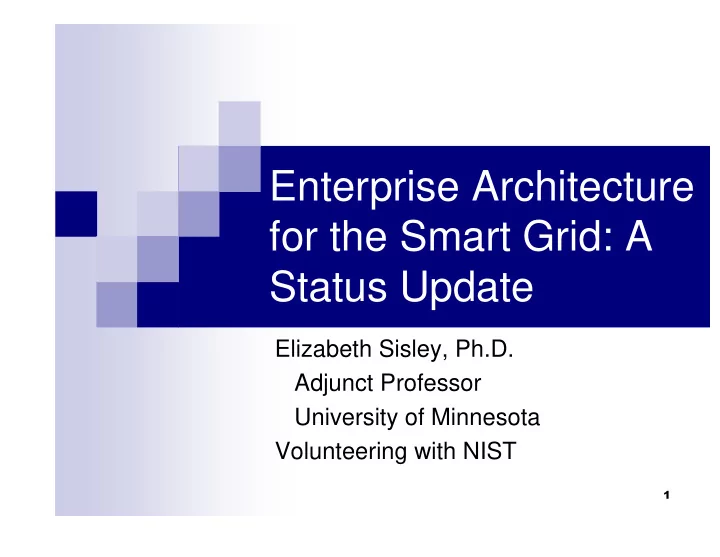

Enterprise Architecture for the Smart Grid: A Status Update Elizabeth Sisley, Ph.D. Adjunct Professor University of Minnesota Volunteering with NIST �
National Institute of Standards and Technology (NIST) � Under the Energy Independence and Security Act (EISA) of 2007, NIST has "primary responsibility to coordinate development of a framework that includes protocols and model standards for information management to achieve interoperability of smart grid devices and systems..." � For additional information on NIST's role and activities, see http://www.nist.gov/smartgrid/. �
NIST Interagency Report, Feb draft � Developed by members of the Smart Grid Interoperability Panel–Cyber Security Working Group (SGIP–CSWG), formerly the Cyber Security Coordination Task Group (CSCTG). � The group is chaired by Annabelle Lee of NIST. � “Smart Grid technologies will introduce millions of new intelligent components to the electric grid that communicate in a much more advanced ways (two-way, with open protocols) than in the past. Because of this, two areas that are critically important to get correct are Cyber Security and Privacy.” �
�
CSWG Architecture Group: Goals � Provide conceptual, physical, and functional diagrams including a harmony between the three � Single high level diagram encompassing entire smart grid � More detailed diagrams of each Smart Grid domain � Major data flows labeled in functional and physical diagrams (similar to current FERC 4+2 diagrams) � Data flow reference numbers consistent between all diagrams � Each data flow referencing the use case or source it came from � Scope primarily targets technologies released in the last 5 years or will be released in the next 5 years � Technologies outside of the 5 year windows will be included if the group deems necessary but will need to be labeled accordingly �
Goals, con’t � Conceptual diagrams � Purpose: used to give a non-technical overview of each Smart Grid domain � Use the current cloud diagrams � Functional diagrams � Start with current FERC 4+2 diagrams � May move to or merge with with upcoming ASAP-SG diagrams � FERC 4+2 diagrams need to be synchronized, too much overlap and nomenclature differences �
Goals, con’t � Physical diagrams � Portrays major variants of physical deployments (variants are innumerable) � Shows logical components in each physical asset (to aid mapping to functional diagram) � Shows where physical assets are commonly placed (At utility, in substations, on poles, on homes, etc...) � Identify major standards/protocols used in existing products in each domain or product class � Based on existing and planned vendor products (meaning discussion and participation with vendors) �
� Also called a Domain Model, this one is at a very high level.
Unified Logical Diagram Process � Domain experts created the FERC 4+2 diagrams � Advanced Metering Infrastructure � HAN/BAN � Distribution Grid Management � Wide-Area Situational Awareness (WASA) � Electric Transportation � Electric Storage � SGIP Panel–Cyber Security Working Group combined them into one diagram, unifying Actors and Interfaces � Efforts continue to combine information from multiple sources �
�� Figure 2.1 Unified Logical Architecture for the Smart Grid
Chapter 2 – Logical Architecture and Interfaces of the Smart Grid � includes � an overall functional logical architecture of the Smart Grid – including all the major domains . � This architecture focuses on a short-term view (1-3 years) of the proposed Smart Grid. � The chapter also includes individual logical interface diagrams for six areas: electric transportation, electric storage, advanced metering infrastructure (AMI), wide area situational awareness (WASA), distribution grid management, and home area network/business area network (HAN/BAN) 12 . � These lower level logical interface diagrams provide a more granular view of the Smart Grid domains. � All of the logical interfaces included in the six diagrams are included in the overall functional architecture . 12 This was previously named Demand Response ��
��
��
Additional Information in NISTIR � Chapter 1 – Cyber Security Strategy : includes background information on the Smart Grid and the importance of cyber security in ensuring the reliability of the Grid and the confidentiality of specific information. � … see previous slide for Chapter 2 � Chapter 3 – High Level Security Requirements : specifies the high level security requirements for the Smart Grid. � Chapter 4– Privacy and the Smart Grid : includes a privacy impact assessment for the Smart Grid with a discussion of mitigating factors. ��
��
Additional Information, con’t � Chapter 5 – Standards Review : includes a review of the standards that were identified in the workshops that NIST conducted and others that have been identified through the Priority Action Plan (PAP) process. � Chapter 6 – Research and Development (R&D) : includes R&D themes that identify where the state of the art falls short of meeting the envisioned functional, reliability, and scalability requirements of the Smart Grid. ��
Appendices in NISTIR � Appendix A : key power system use cases with security applicability used in the risk assessment process � Appendix B : crosswalk of cyber security documents used in developing the security requirements � Appendix C : vulnerability classes used in the risk assessment process � Appendix D : bottom-up security analysis of the Smart Grid used in the risk assessment process � Appendix E : state laws – Smart Grid and electricity delivery regulations � Appendix F : acronyms and glossary � Appendix G : SGIP-CSWG membership. The requirements included in this NIST report will form the basis for the standards and guidelines developed with coordination by NIST and the SGIP. ��
Upcoming Minnesota Events ��
��
Contact Info � Elizabeth Sisley, U of M � sisley@cs.umn.edu � 651-730-5159 � Annabelle Lee, NIST � annabelle.lee@nist.gov ��
Recommend
More recommend